Summary
Many people cannot find Office (or other applications) after installing it on Windows 8 / 8.1, simply because they are not familiar with the Metro UI. Here are some instructions for finding "missing" applications and for customizing the Start Screen and Desktop to make it easier to find these applications in the future.
Details
The "new & improved" Windows 8 / 8.1 "Metro" User Interface takes a little getting used to. It uses different concepts than the "traditional" desktop. This makes it unfamiliar and unfriendly to many people, especially if they have just received a brand new Windows 8 / 8.1 computer and do not have experience with touch phones or tablets.
There are several ways to find an application in Win 8, both "traditional" and new methods
- invoke the Windows 8 search function
- scroll "down/right" on the Start Screen
- check "All Apps" tile view
- check Programs and Features
#1 Windows 8 Search Function
The simplest way to find a program Tile or Shortcut is to simply use the Windows 8 Search function. All you have to do is start typing the program name directly on the Windows 8 Start Screen. Typing on the Start Screen invokes the search function. Type the name you expect to see on the Tile or Shortcut, for example "Microsoft Word 2013". You can also type the program name, for example "WinWord.EXE". Note: typing the program name won't work for Office 365 type installations.
#2 Scroll on the Start Screen
When you install a new program on Windows 8, the new "Tiles" are automatically placed on the extreme right end of the "Start Screen". On a mouse driven computer you can "Scroll down" on the mouse to scroll the Start Screen from left to right. On a Touch screen, drag your finger from right to left.
Note: in Win 8.1 this does not apply. In Win 8.1 tiles for newly installed programs are no longer placed anywhere on the "Start Screen". Tiles for all new apps are ONLY placed on the "All Apps" view of the start screen. In the All Apps view you will have to select which new app tiles to place on the start screen.
#3 Check the "All Apps" view
The "All Apps" view lists all of the installed programs on your computer. Right click anywhere on the Start screen to display a pop up task bar at the bottom of the screen. On the far right end of this task bar is the "All Apps" icon
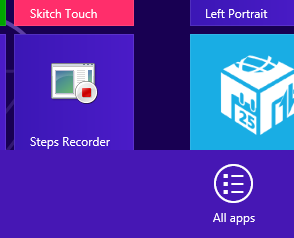
Like the Start Screen you will probably have to scroll to the right to see all of the tiles. The list of tiles starts with individual programs and "Metro" programs, then it is followed by programs that are grouped under titles. Although it is not easy to
see, the top of the last column in the screen capture is the "Group Name" "Administrative Tools".

If you know the group name for the program you are looking for you can also switch to an alphabetical shortcut view by using <CTL><Scroll Down>
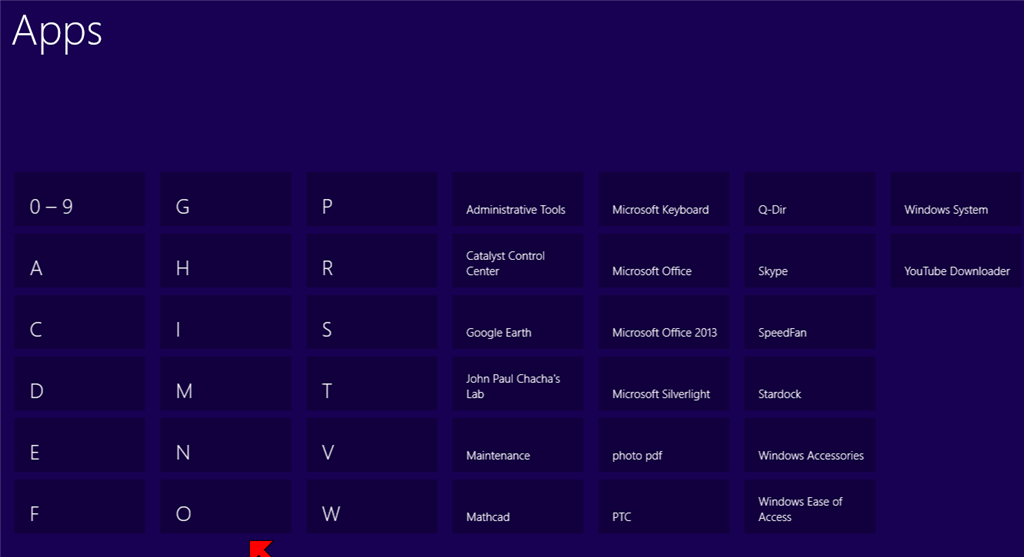
#4 Check Programs and Features
Go into Control Panel > Programs and Features. Scroll down to find an entry to confirm that the program / suite has been installed. By default the dialog sorts on the Name column, If you recently (like today!) installed the application, you can also click
on the "Installed On" column heading to sort by installed date.
Note: click twice to reverse the sort, to show the most recent dates first
Now what is next?
One thing to remember is the split between "traditional" desktop applications, like Office 2013, and the new "Metro" applications. Desktop applications can have simple tiles on the Start Screen as well as the "traditional" shortcuts on the Desktop. "Metro"
applications can have simple or advanced (live data) tiles only on the Start Screen. You can quickly toggle between the new Windows 8 "Start Screen" and traditional "Desktop" by simply hitting the <Windows> key.
You found that your program has been installed but you don't want to <scroll><scroll><scroll>.... every time to reach the tiles, or the tiles are only on the All Apps view. There are a few things you can do
- Get used to using the Windows 8 search function
- Drag tiles to the left
- Pin Tiles to the Start Screen
- Pin Tiles to the Task Bar
- Create Shortcuts on the Desktop / Pin Tiles to the Desktop
#1 Use the Windows 8 Search Function
If the tile I am looking for is not on the default start screen, I have learned that it is just as fast to type the name to invoke the search function as it is to grab the mouse and scroll till I find the tile.
Drag to the Left
When the tiles are on the Start screen, you can simply click and drag them to the left to place them onto the default screen where you can see them all the time. Personally, I have found that keeping the tiles in 1 or 2 column groups allows me a greater
degree of control over where they are placed. In this example I have placed 3 "favorite" tiles in the top rows and created 2 groups of 2 columns for my various Office application version programs
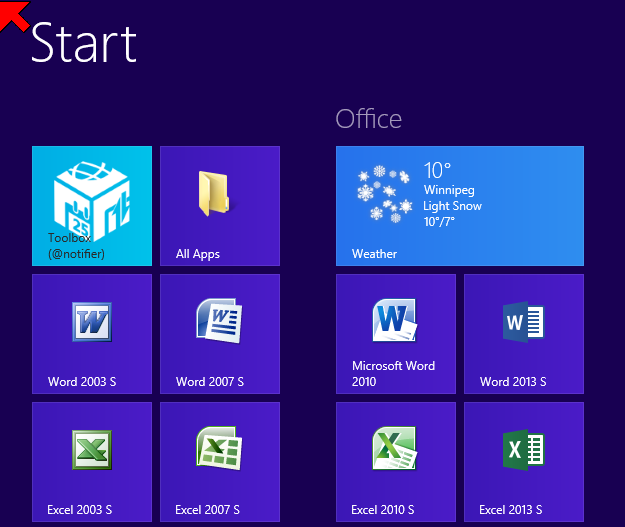
This article goes into detail on how to move tiles around on the screen, how to group them and how to name the groups:Group
Shortcuts on the Start Screen & Name Them
#3 Pin Tiles to the Start Screen
If the tile only exists on the "All Apps" view, you should move it to someplace easier to access. The first place to consider is the Start Screen. In the "All Apps" view right click on one or more tiles you want to move to the Start Screen. Then pick "Pin
to Start Screen" from the task bar at the bottom of the screen. The capture below shows that I actually, already have the PowerPoint 2010 tile pinned to the Start Screen (the first Icon toggles between "Pin" and "Unpin")
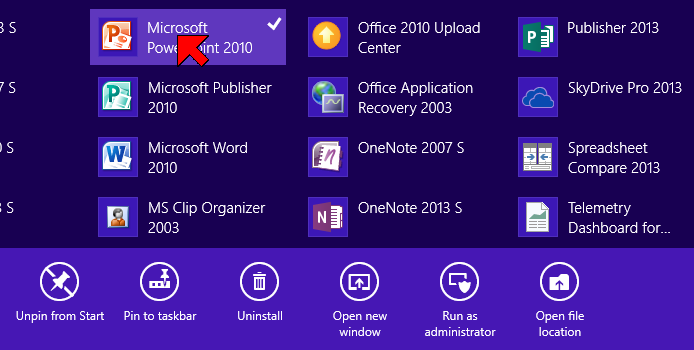
#4 Pin to Taskbar
For a very limited number of frequently used desktop programs (the option will not be displayed for Metro apps) you can pin them to the taskbar that is displayed on the desktop. Since space is limited on the task bar this is not a good replacement for the start menu.
#5 Create Desktop Shortcuts
You can also create "traditional" shortcuts on the desktop to access applications and files. In the screen capture above, select the "Open File Location" option. This will open Windows File Explorer in the location of the file with it selected. In this example, the tile is actually a traditional Start Menu shortcut, but it could also be pointing directly to the EXE file in some cases:
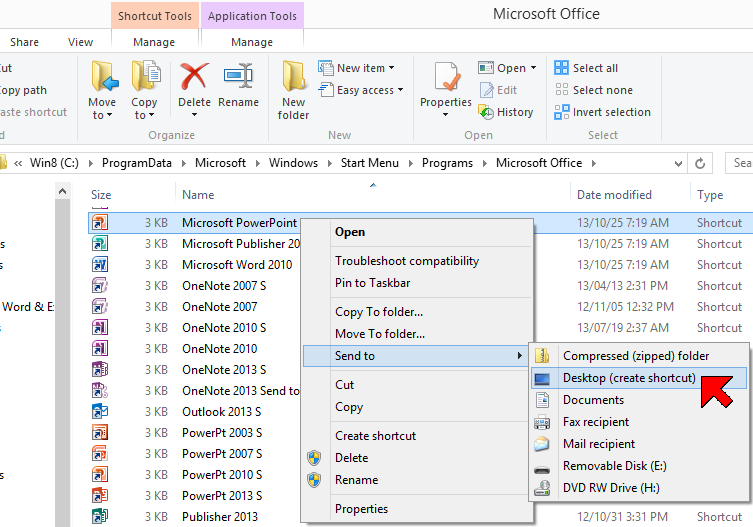
Right click on the shortcut or program and select "Send To", the select "Desktop (create shortcut)". This will create a shortcut for you on the desktop.
This article goes into more detail on pinning programs and files:The Complete Guide to Pinning Everything to the Windows 8 Start Screen
